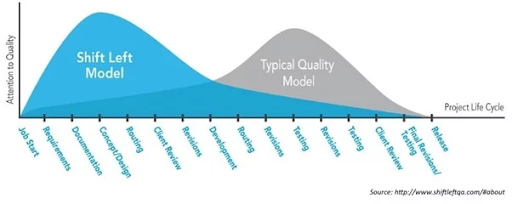Due to the increasing complexity of producing and delivering high-quality, secure software at today’s competitive pace, testing procedures are shifting to the left in the software development process. Agile techniques and the DevOps approach were developed to meet these demands.

Traditional Testing
In a conventional waterfall software development project, testing would have occurred shortly before delivery into production. Hence, if any bugs or usability issues were detected, the release would be delayed until they were fixed.
In this arrangement, testing created a bottleneck that substantially hampered a project’s ability to deploy on time.
What Is Shift Left Testing?
The process of moving the testing phase earlier in the software development lifecycle is what shift left testing refers to. We wish to avoid techniques that just do testing at the end of the software development life cycle. Instead, we introduce testing in the early phases of software development by moving left.
A typical software development method was sequential until the late 1990s. Only towards the conclusion of the software development lifecycle do stakeholders pay attention to detail and prioritize quality. Special emphasis is given to the phases of testing and deployment at this time only. Testing occurs at the conclusion of the project’s life cycle in this sequential paradigm.

Due to this, however, software developers or product owners frequently discover issues at the very last stage of the software development lifecycle. And it is extremely expensive and time consuming to fix such bugs at this late stage. In the worst-case scenario, engineers have to rethink the entire program.
The concept of shifting testing left arose out of this need to incorporate the testing team as early in the software development process as feasible.
Why Is It Important?
The requirements are retained on the left side of the plan in the traditional software development paradigm, while the delivery and testing requirements are kept on the right. The difficulty is that these techniques are incapable of dealing with changing expectations and requirements, resulting in bad business results such as cost increases, a longer time to market, unexpected errors, etc.
The cost of moving your testing to the left is a powerful incentive in and of itself. According to estimates, more than half of all software problems may be recognized at the requirements phase, with fewer than 10% appearing during the development phase of the life cycle. A flaw that is discovered and removed after the product has been released can cost about 100 times more than one that is discovered and removed during the requirements phase.
Benefits
One of the biggest benefits of shift left testing is automation. Shifting to the left increases the possibility of automating testing. Some crucial advantages of test automation include fewer human errors, enhanced test coverage (multiple tests can be conducted at the same time), allowing testers to focus on more interesting and gratifying assignments, and fewer production problems
Additionally, shift left testing permits accelerated delivery. When errors are discovered early in the manufacturing cycle, they may be corrected much more quickly. Because of this, the period between releases can be greatly reduced, software quality is improved, and there is increased contentment.
A significant advantage of the shift left strategy is faster delivery of software with fewer errors. If nothing else convinces you that this is a wise decision, the grins on your business colleagues’ faces should be enough.
Summary
The advantages of shift left testing are obvious. We can assure improved code quality by finding and lowering the number of problems early in the software development life cycle. Most importantly, by including testing in the early phases of software development, the development team will save time and money.

